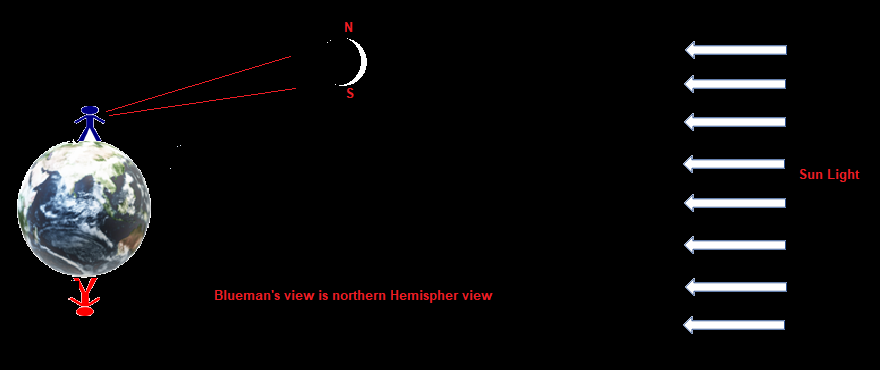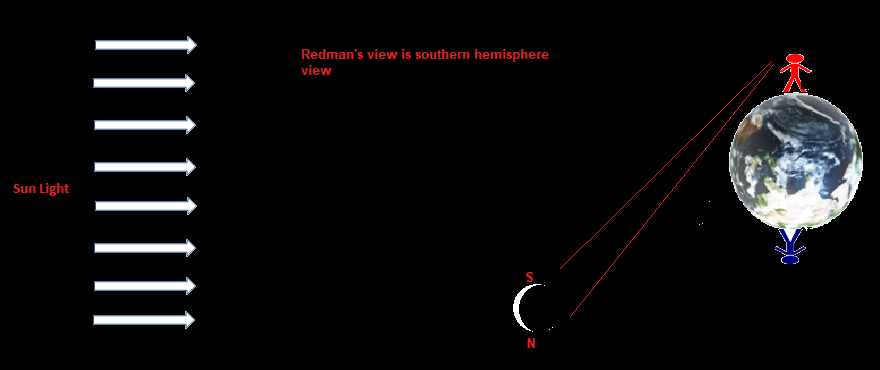Crescent Moon
Shapes
Waxing vs Waning
Northern vs Southern Hemisphere
Watch this video that gives the summary of this post.
Is it 'C' or ‘Ɔ’ ?
Often, we see the crescent Moon in the sky and also as part of many scenic pictures. Have you ever noticed the shape of a crescent Moon? If you carefully look at those pictures, you will notice that in some pictures the crescent Moon is like a ‘C’ while in others it is like ‘Ɔ’ (An inverted ‘C’). Have you ever wondered why?
You might have rightly guessed that those pictures must have been taken from two separate locations or at two separate times. Any idea how the location and the timing determine the shape of a crescent Moon? Let us find out.
The shape depends on two different scenarios:
- Waxing Phase or Waning Phase
- Northern Hemisphere View or Southern Hemisphere View
Let us look into the first scenario now.
First Scenario:
Waxing or Waning Crescent?


The first scenario is simple. The shape difference happens when you observe the Moon in two separate phases, keeping your viewing location fixed. We see the waxing crescent appearing one way and the waning crescent looking like a mirror image.
Waning Crescent
For instance, Picture 1 shows a waning crescent appearing in the eastern sky in the early morning hours. This picture was taken from a place near New York city, 11 days after full moon day. It looks like a ‘C’.
Waxing Crescent
In contrast, picture 2 is a waxing crescent. This picture was taken from a town near New York city, 4 days after the new-Moon Day, in the evening hours. It was on the western sky, and it appeared like ‘Ɔ’.
Therefore, the shape of a crescent Moon depends on whether you are viewing a waxing crescent Moon or a waning crescent Moon. When viewed from northern hemisphere, the waxing Moon appears like ‘Ɔ’, and the waning moon looks like a ‘C’.
In the next section, we will discuss the scenario number two: how the location (hemisphere) determines the shape.
Second Scenario:
Northern Vs Southern Hemisphere view
The second scenario considers your viewing location. The shape of a crescent Moon depends on if you are seeing the crescent Moon from the northern hemisphere or from the southern hemisphere.


New York City Vs Chile
To make the point clear, let us consider two specific locations: one in the northern hemisphere and the other in the southern hemisphere.
Assume that you are in New York city (latitude: 40.7° N, longitude: 74.0° W). And you look at the western sky at sunset, three or four days after a new Moon Day. If it is not cloudy, you should be able to see a waxing crescent. It appears like ‘Ɔ’ as in Pic 3.
While you are admiring the waxing crescent Moon from New York city, imagine you receive a call from your friend who is in Chiloe Island (see pic 5; latitude: 41° S, longitude: 74.0° W) in Chile, which is in the southern hemisphere.

If you ask your friend how the Moon appears there in Chile, he will answer that it is like a ‘C’ as in Pic 4. He is right. He not only sees the mirror image of your view but also sees it upside-down. Compare the pictures 6 and 7 which are pictorial representation of the northern hemisphere and southern hemisphere views. You are the blue man. And your friend in Chile is the red man.
North View vs South View


To conclude, the shape of a crescent Moon depends on the phase of the Moon (waxing or waning) and also on the viewing location (northern hemisphere or southern hemisphere)
In the waxing phase, it is a ‘Ɔ’ from the northern hemisphere (a ‘C’ from southern the hemisphere).
It is just the opposite during the waning phase: it appears like a ‘C from the northern hemisphere (a ‘Ɔ’ from the southern hemisphere).
An interesting question may come up now: What does the waxing or waning Moon look like from a place on the equator? The answer is it looks like a boat.
